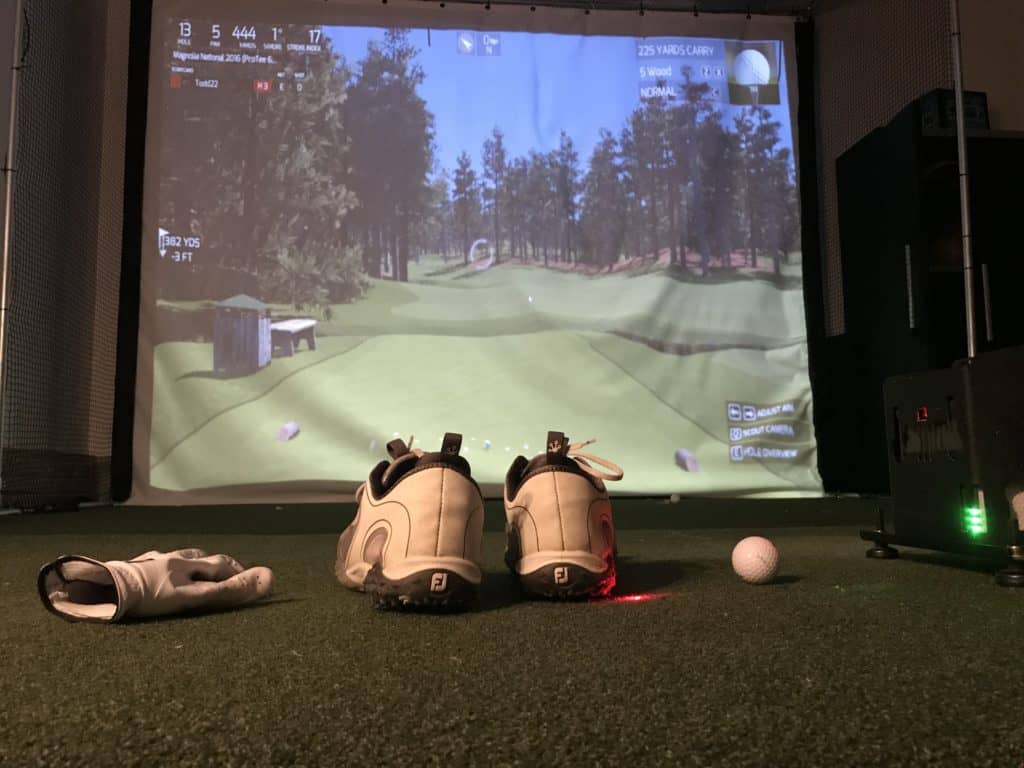Golf can be a complicated game.
It can also be one of the most rewarding, fun journeys in all of life. If you take the right steps to getting better, golf is a ton of fun!
The ultimate journey to play your best golf and play your best golf when it counts the most is exhilarating and hooks people into the challenge!
The joy and satisfaction with scoring your best round ever or smashing your furthest drive is difficult to match!
It seems that many former athletes take up the game of golf when they retire or quit their primary sport and absolutely fall in love with the game of golf.
I attribute this to the journey that golf sends you on. The physical and mental challenge that comes with every 18 hole round of golf over 4 hours is hard to replicate in other experiences.
One of the questions I often hear is can you teach yourself to play golf?

Can You Teach Yourself To Play Golf?
Yes you can. With trial and error and utilizing the many available resources you can! However, the journey will take a longer time and the amount of frustration that could set it could lead someone to walking away from the game.
Below I recommend taking the following steps to help teach yourself the game, but also to be smart about it. I understand that everyone might not have the resources to take a lesson whether that is time or money.
Growing up, I did not have access to the lessons and to this day I have only taken one lesson my entire life and I average between 70-74 when I play 18 holes of golf. It can be accomplished, but it will take longer!
There are 7 steps to take:
- Learn as much as you can about the golf swing
- Work on these 3 key fundamentals
- Utilize these 3 drills
- Seek feedback from someone knowledgeable
- Play and practice often
- Understand the ball flight laws
- Invest in some golf technology
Step #1: Learn as much as you can about the golf swing!
The golf swing is complicated. There are many angles, bends, tilts and power sources that can make or break your swing.
If you want to truly get to the elite level, learning from someone and having that person serve as a guide or mentor will go a long way in speeding up the process.
I would highly recommend checking out some of the many resources online via youtube. There are some great instructors that we now have access to in the era that we live.
In past decades, we had to wait for the monthly major golf publications to arise and even then we never really got a full system.
With today’s golf instructors posting free content on the different social media sites, the ability to learn about the swing is endless. Please note that not every golf instructor is the same and some have different methods or approaches to the game.
If you are following multiple instructors, you might find that the information can be contradictory.
I highly recommend checking out our different reviews below and then diving into one instructors.
Here is a list of golf instructors that I have reviewed:
I would highly recommend any of these instructors. Check out their personalities, access to free videos, approach to the game and see which one best matches with your personality, communication style and maybe your existing swing and approach to the game.
I am confident that anyone of these instructors linked above can help you improve and grow your game.
George Gankas is the most recent, most popular golf instructor to hit the PGA Tour. Mike Malaska is great at simplifying the game. Shawn Clement takes the positions out of the swing and instead focuses on making movements. Monte has a wonderful way to explain why certain things happen in the swing. Bobby Lopez is hilarious and Jim Venetos is the most alternative swing of those listed above.
Find which one you best mesh with and dive in and commit to their approach!

Step 2: Work on these 3 key fundamentals
The Stack and Tilt Instructors said it best when they described what they believed were the fundamentals of golf. They explained it somewhat similar to this:
- Fundamental #1: The golfer’s ability to control the bottom of the golf swing. The best golfers will hit the ground in the intended spot, close to 100% of the time.
- Fundamental #2: The golfer’s ability to control the curve of the golf ball. The best golfers are able to start the ball to the right or left of the target line and have the ball curve towards the target without the ball over curving past the target.
- Fundamental #3: The golfer’s ability to have enough power to play the golf course. This means they are able to hit the ball far enough to play the course in regulation.
If you really think about it, if a golfer can strike the ball solid (fundamental #1), control the start line and curve of the ball (fundamental #2), and have enough speed and length to play the game then they are all set!
There are great golfers that have used a strong grip and those that have used a weak grip. Some use an open stance, while others use a closed stance.
There are some that move off the ball and others that stay centered. The grip and stance are often taught as fundamentals, but they can’t be fundamentals if they range from golfer to golfer. However, take any professional golfer and they hit all three fundamentals above!
Learn more about the Stack and Tilt here.
Step 3: Utilize these 3 drills
The three drills below will help you develop the three fundamentals listed in step 2. Practice these drills frequently and get better at ball striking, controlling the ball and developing the speed in your game!
Golf is a wonderful game when you can do these three things and these drills are phenomenal to help you get better quicker! Two out of the three can be done in your backyard!
Drill #1: Low Point Control Drill
The Drill: The Low Point Control Dril
- Take some yard paint and patina a 1-2 yard long line.
- Setup with 55% of your weight on your front side.
- Try to hit the target side of the line and see how many times out of 10 you can do this successfully!
- Repeat this drill every day for a month, tracking your progress and your ability to to this successfully in trials of ten.
- You may need to start with half swing and progress to full swings.
Drill #2: Build A Stock Shot
A stock shot allows you to control your start line and your curve, which is the 2nd fundamental in golf. I would recommend the stock draw shot. Here is a drill you can practice at the driving range:
- Setup an alignment stick about 7 to 10 yards in front of you on the target line.
- See how many shots out of 10 you can start to the right of the target.
- Track this data over time and continue to work on your start line.
The goal here is to get the club face pointing in a similar direction as many times out of 10 as possible. Once we get the ball starting the right spot, we can then move onto the curve of the ball.
If your ball is starting to the right and curving to the right, let’s work on getting your swing path more to the right, which will then help you hit a draw.
Practice this every range session you have for at least 20-30 golf balls. Don’t just stand at the range and aimlessly hit golf balls. This drill can be a game changer for many golfers.
Drill #3: Train For Speed
Let’s face it, regardless of the current state of your game we all want more speed. It has become very clear the need for speed in the golf swing and there are ways to add speed!
The analytics on all levels of golf show how important speed and additional speed are in reducing golf scores.
It is time to start training for some additional speed. This is a drill and training protocol that I would highly recommend.
SPEED DRILL: Increase your swing speed through overspeed training
- Check out SuperSpeed Overspeed Training Protocols
- Train every other day for 10-15 minutes.
- See a 4-6% increase in swing speed as early as the first training protocol.
The number one thing that has helped me gain significant distance is the SuperSpeed Training System. This overspeed based system where you train every other day for about 10-15 minutes with different swing sticks can help you increase your swing speed by 5-8% which can be 20-30 yards.
Who wouldn’t want an extra 20-30 yards. Plus it helps improve your mechanics.
SuperSpeed Golf – Use Discount Code Golfjourney365 for some savings!
The analytics are pretty clear on the importance of speed in the game of golf. Would you rather hit your approach shot from 130 yards of 160 yards?
The answer is pretty simple! We know that over the course of time, we will hit shots from 130 yards much closer than from 160 yards, whether we are an average amateur golfer, a scratch golfer, or a PGA Tour member!
The key is having shorter approach shots, so we can hit the ball closer to the hole and then make more putts! Speed is king in the game of golf! Make sure you check out SuperSpeed Golf!
Step #4: Seek feedback from someone knowledgeable
Feedback is an essential element to all learning. If you are going to teach yourself the golf swing, it is important to get feedback at key times. There are numerous ways to get feedback, you just have to make sure you are getting it from the right place.
One option is to record your golf swing with your smartphone and take a look at your overall tempo and swing to see if anything looks complete off base.
The second option is to find someone online that wil give you a free review. Bobby Lopez is worth checking out to see if he is still offering a free review to start. Be aware that you swing might be easy to tear apart and you have to be open to the feedback and the adjustments that you need to make.
You can also join some membership sites for feedback on your swing. These do cost money, but they can help speed up the process!
Step #5: Play and practice often
Golf is fun. We want to play golf often and should enjoy the journey. Consider a membership at a local driving range or golf course to have access as much as possible.
I built a golf simulator in my garage and saw my average score decrease by 4 shots and I was already in the 70s. The key being the ability to hit balls almost daily, get great feedback from the ball data and play some of the best courses in the world!
This is a wonderful combination to really get better at golf and to get better at golf quickly!
Here are some excellent resources if interested in a golf simulator:

Step #6: Understand the ball flight laws
Why? If you understand the ball flight laws you can start to become your own swing instructor and make corrections on the range or the course by reading the flight of your golf ball.
Too often golfers turn to the video of their swing when everything you need to know can be read off of your ball flight. Did you know that your ball flight can tell you the following:
- Where your club face was at impact.
- If your swing path was left or right of the club face.
Once you know these two items you can make the corrections by checking out our 2nd Tip on understanding what swing thoughts can help you get the proper matchups.
So let’s dive into the ball flight laws:
- Generally speaking, the golf ball will start where the club face is aiming.
- The golf ball will then curve away from the swing path.
There are two different lines that we must understand. The target line and the start line. The best golfers start the ball left or right of the target line and then curve the ball back towards the target.
Let’s go over some examples to help you better understand the ball flight laws.
Example A: Let’s say that the club face is 3 degrees right of the target line and the swing path is 5 degrees right of the target line. What will the ball do?
Answer: The ball will start right of the target line and draw back towards the target. This is known as a push draw.
Example B: Let’s say the club face is 3 degrees right of the target line, same as in example A, but the swing path is only 1 degree right of the target line. What will the ball do?
Answer: The ball will start to the right of the target line and will fade to the right. Keep in mind that the ball will curve away from the swing path. In this example, both the club face and the swing path are to the right and the ball will curve away from the path.
Example C: Let’s say the club face is 3 degrees to the left of the target line and the swing path is 5 degrees left of the target line. What will the ball do?
Answer: The ball will start to the left and curve to the right. This would be a pull fade or pull slice. Keep in mind that even though the face is closed to the target line, it is open to the swing path and the ball will curve away from the swing path.
Example D: Let’s say the club face is 3 degrees to the left and the swing path is only 1 degree to the left. What will the ball do?
Answer: The ball will start left and curve left. This shot would look like a pull draw.
Hopefully, these examples help you understand the club face and swing path correlation and how they match up. Once you understand these ball flight laws, it will help you read your own shots and possibly make in round adjustments.
Step #7: Invest in some golf technology
There are so many great tools, but nothing more valuable than the golf launch monitor. Pros have been using the most expensive units on the market for close to a decade now. Amateurs now have access to some key information at a much lower cost.
It can be helpful to know your swing path and club face direction at impact. In today’s golf world, even amateurs can have access to this technology and data with the technology now available.
The professional golfers of today all have access to some great technology including launch monitors to help measure their swing and know their numbers.
Can an amateur use this same or similar technology for game improvement? Yes, absolutely and I would highly recommend it.
Even if you aren’t going to go all out and build an indoor golf simulator like I did (see above), you can still pick up a launch monitor at a reasonable price and use it in your indoor net or taking to the course or driving range with you!
Know numbers like spin rate, ball speed, spin axis and other key information is vital to your growth. Sharing these numbers with your instructor can be helpful and help with equipment selection as well.
I would recommend one of the three launch monitors listed below:
Final Thoughts: Can you teach yourself to play golf?
At the end of the day, it is possible, but make sure you put our 7 steps into play here. If you want go get an intro lesson and then jump into your 7 steps.
All of our 7 steps can continue to be repeated for a while and if you focus on these areas you can get better.
One area that I left off is the short game. The short game is the fastest way to get better, especially when you are starting off. Don’t forget to get the practice green at least for 30-60 minutes per week and play some games to help you improve.
The great thing about the short game is that it doesn’t take great athletic ability, technique or power to be an awesome short game player. It does take practice and time!
I am an amateur golfer on a journey to get better, enjoy the game as often as possible and share my passion and knowledge with others. I have coached high school golfers at a high level and have a great passion for the game and want to give back. I enjoy learning about the golf swing and am currently studying to be a certified professional golf instructor. Join me in our journey to get better everyday. Thank you for reading!

